
Aims
This guide explains the benefits, purpose, and principles of developing a breed health improvement strategy. It is designed to provide a practical guide for breed health coordinators and clubs/councils to help them assess and enhance their current approaches for improving their breed’s health.
Contents
Introduction to health improvement stratergies
What is a breed health improvement strategy?
Most breeds have appointed a breed health co-ordinator and many clubs/councils also have health and welfare sub-committees. These people usually take the lead in developing plans for identifying and addressing any health issues that may be present in their breed.
Sometimes, there is a lot a breed would like to do, but it doesn’t feel like there is enough support to do it. It can also be unclear how everything you do fits together, or even if it does fit together. Given that situation, how can you be sure that your breed is:
Tip: A breed health improvement strategy is much broader than a plan for addressing a particular health issue (e.g. a single disease or condition) in a breed.
Sometimes, there is a lot a breed would like to do, but it doesn’t feel like there is enough support to do it. It can also be unclear how everything you do fits together, or even if it does fit together. Given that situation, how can you be sure that your breed is:
- doing enough of the right things?
- doing them fast enough?
- actually achieving the health improvements you need to make?
Tip: A breed health improvement strategy is much broader than a plan for addressing a particular health issue (e.g. a single disease or condition) in a breed.
Why does every breed need one?
Most breeds are dependent on breed clubs, their members, and responsible breeders to ensure a healthy future. They are also influenced by current owners and potential future puppy buyers, without whom a breed is unlikely to be viable in the long term.
Ensuring a breed’s long-term future is becoming increasingly challenging, considering:
The establishment of the Independent Advisory Council on the Welfare Issues of Dog Breeding in 2010 further reinforces the importance of having effective breed health improvement strategies, so we can demonstrate the plans and progress our breeds are making.
Developing a breed health improvement strategy is a process that focuses on understanding what the priorities are in your breed, developing ways to address these and making sure real improvements are achieved.
There is no “quick fix”; it will take time and hard work. Success will be achieved if everyone works together for the benefit of your breed.
If you don’t have a breed health improvement strategy, your breed is at risk.
Tip: Breed health improvement is not the responsibility of the breed health co-ordinator, or even of your health and welfare sub-committee; it is the responsibility of everyone who loves your breed and wants to ensure it has a healthy future.
Ensuring a breed’s long-term future is becoming increasingly challenging, considering:
- Puppy buyer and pet owner expectations that their dog will live a long and healthy life
- Competition from breeders of so-called “healthier”, “designer" breeds, who can often sell puppies for as much, or more, than many pedigree breeds
- Calls for legislation to control, or ban, the breeding of some pedigree breeds; either because of their conformation/health or their temperaments
- Lobbying from campaign groups and individuals who feel strongly about the need to improve the health of pedigree dogs and who feel frustrated by slow progress
The establishment of the Independent Advisory Council on the Welfare Issues of Dog Breeding in 2010 further reinforces the importance of having effective breed health improvement strategies, so we can demonstrate the plans and progress our breeds are making.
Developing a breed health improvement strategy is a process that focuses on understanding what the priorities are in your breed, developing ways to address these and making sure real improvements are achieved.
There is no “quick fix”; it will take time and hard work. Success will be achieved if everyone works together for the benefit of your breed.
If you don’t have a breed health improvement strategy, your breed is at risk.
Tip: Breed health improvement is not the responsibility of the breed health co-ordinator, or even of your health and welfare sub-committee; it is the responsibility of everyone who loves your breed and wants to ensure it has a healthy future.
The benefits
Owners and potential puppy buyers of your breed expect:
- a dog that is fit for its function (invariably, as a pet and companion)
- a dog that will live a long and happy life, free from health problems
- not to have to spend lots of money on veterinary fees caused by their dog’s conformation and breeding
- to be able to talk positively about all the actions they are taking to ensure the breed is healthy
- to be confident that club members and breeders fully support their plans for breed health improvement
- to be proud of their efforts to improve the breed’s health and welfare
- your breed’s clubs/council to be proactive in working for the benefit of the breed
- your breed’s clubs/Council to adopt relevant, good practices that are being demonstrated by other breeds
- to be able to work in partnership with your breed to support health improvement
- your breed’s commitment to its future health
- that you recognise the value of continuously focusing on health priorities and implementing actions to improve health and welfare
- that the positive steps you are taking are making a difference to your breed
What would a good breed be doing?
If you ask a group of breed health co-ordinators, or club/council committee members, the chances are they’d come up with a long list of things they’d say a “good” breed would be doing to improve health and welfare. The questions that then follow are:
- Which ones should your breed be doing?
- Which ones are your breed doing?
- How successful are you at doing them?
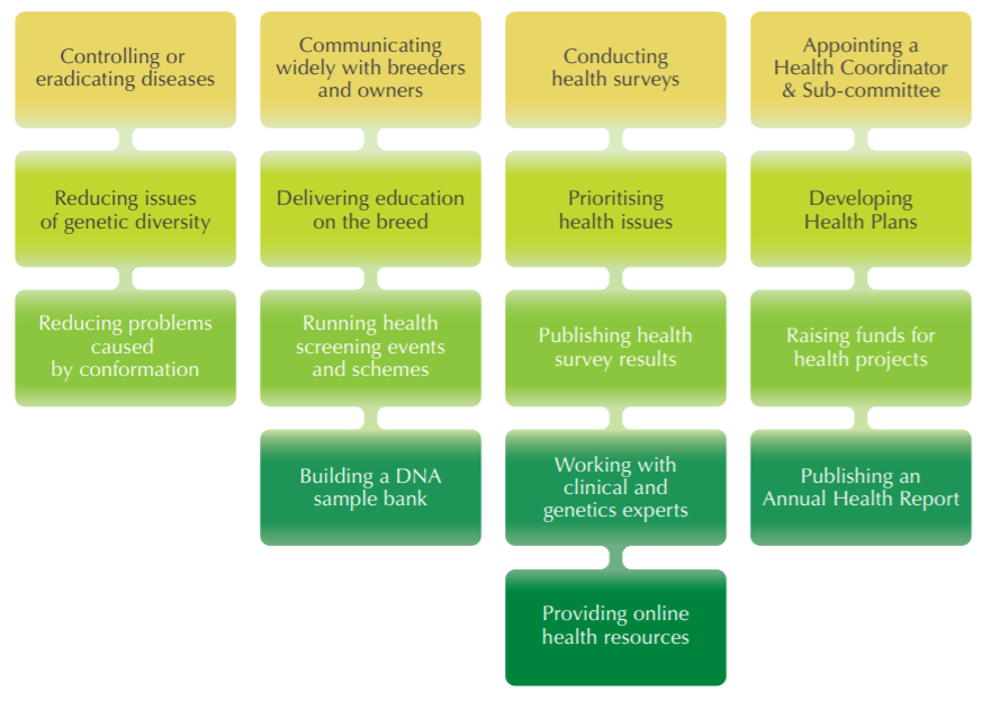
These examples aren’t meant to list all of the actions that any particular breed might be doing and we’ll see in the following sections of this guide more examples and how you can decide what is right for your breed.
Four themes for a breed health improvement strategy
An effective breed health improvement strategy has four underpinning themes, each of which is supported by a number of activities that a breed could be doing:
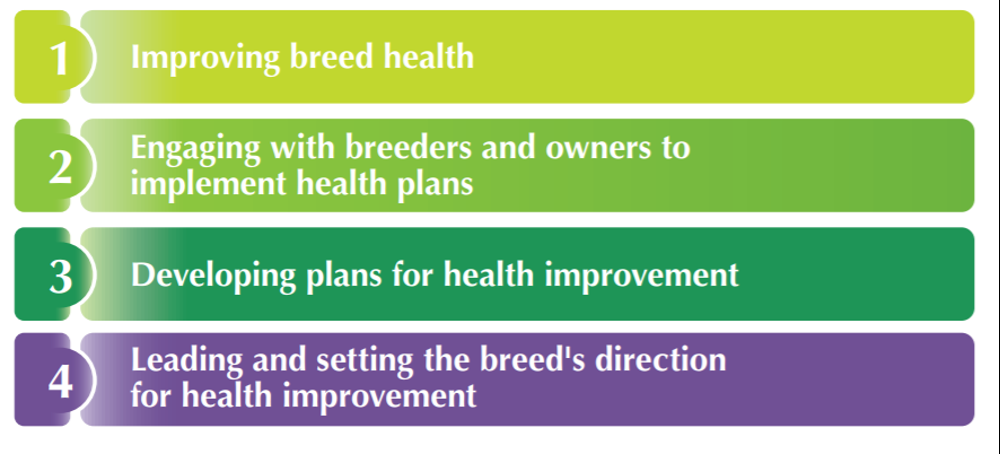
Tip: Your breed needs to be active in all four of these areas.
The four themes must start with leadership and setting the direction for health improvement. This is followed by putting specific plans in place, which then have to be supported by breeders and owners. Unless these people adopt the plans, no health improvement will be achieved.
Everything starts with leadership and there is a clear role for breed health co-ordinators in demonstrating that leadership.
You might also be asking why, in the diagram below, there is a link between the final “improve” theme and the first “lead” theme. The simple answer is that you need to be clear what you need to improve and how successful your actions are, in order to be able to lead and set the future direction for your breed.
The four themes must start with leadership and setting the direction for health improvement. This is followed by putting specific plans in place, which then have to be supported by breeders and owners. Unless these people adopt the plans, no health improvement will be achieved.
Everything starts with leadership and there is a clear role for breed health co-ordinators in demonstrating that leadership.
You might also be asking why, in the diagram below, there is a link between the final “improve” theme and the first “lead” theme. The simple answer is that you need to be clear what you need to improve and how successful your actions are, in order to be able to lead and set the future direction for your breed.

Lead
The importance of leadership
A well-led breed is fully committed to improving all aspects of health and welfare.
A breed’s leaders include:
A breed’s leaders include:
- Officers and committee members of all the breed’s clubs and its council (where one exists)
- Members of the breed’s health and welfare sub-committee
- The breed health coordinator
What evidence might we expect to see?
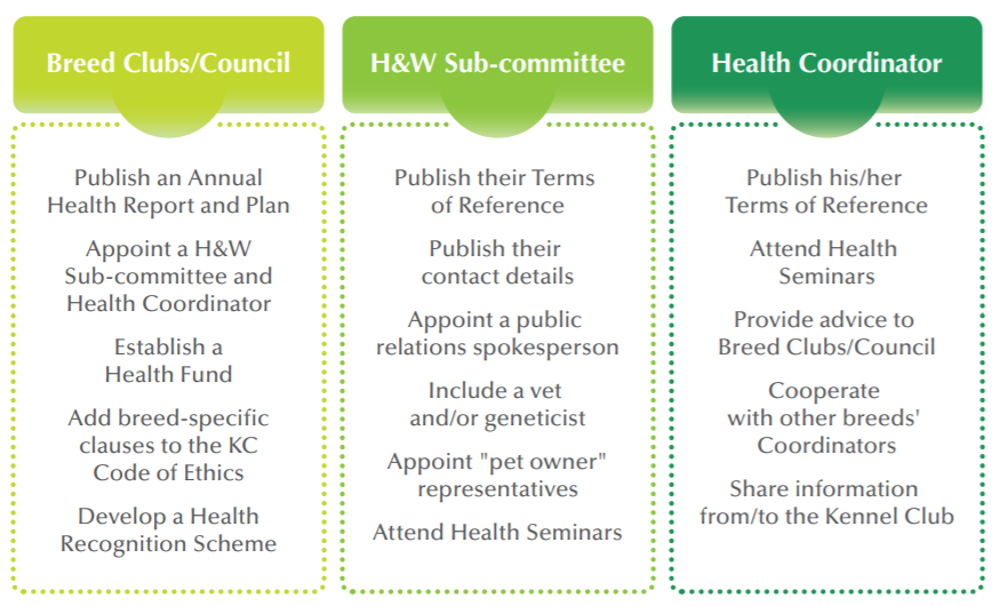
Breed health co-ordinators shouldn’t be a “lone voice” in their breed. You need to form a health and welfare sub-committee to provide more support and more expertise.
If your breed is involved in a range of activities (show, working, obedience etc.) ensure that each of these is represented in the health and welfare sub-committee. This will help ensure you have the widest possible spread of ideas and interests and it gives you a route into communication with each group.
You can find examples of terms of reference for a health and welfare sub-committee in the appendices, together with an example of the roles and responsibilities of an effective breed health coordinator.
Increasingly, breeds are finding that there are individuals, or groups of owners, who are not involved in the breed club community, but who are campaigning for health improvement in the breed. While you might see these people as a potential threat, the reality is that they are passionate about breed health improvement and if you can find a way to work together, it will be a win-win solution.
Tip: In many breeds, the number of pet owners will far outweigh the number of people who participate in specific canine activities, so appointing one or more “pet advisors” is a great way to engage with other owners and get their views.
- If your breed has a breed council, appoint a breed council health and welfare sub-committee
- If your breed has only one club, appoint a health and welfare sub-committee from that club
- If you don’t have a breed council, appoint a health and welfare sub-committee with representatives from your clubs
If your breed is involved in a range of activities (show, working, obedience etc.) ensure that each of these is represented in the health and welfare sub-committee. This will help ensure you have the widest possible spread of ideas and interests and it gives you a route into communication with each group.
You can find examples of terms of reference for a health and welfare sub-committee in the appendices, together with an example of the roles and responsibilities of an effective breed health coordinator.
Increasingly, breeds are finding that there are individuals, or groups of owners, who are not involved in the breed club community, but who are campaigning for health improvement in the breed. While you might see these people as a potential threat, the reality is that they are passionate about breed health improvement and if you can find a way to work together, it will be a win-win solution.
Tip: In many breeds, the number of pet owners will far outweigh the number of people who participate in specific canine activities, so appointing one or more “pet advisors” is a great way to engage with other owners and get their views.
Check: How well led is your breed?
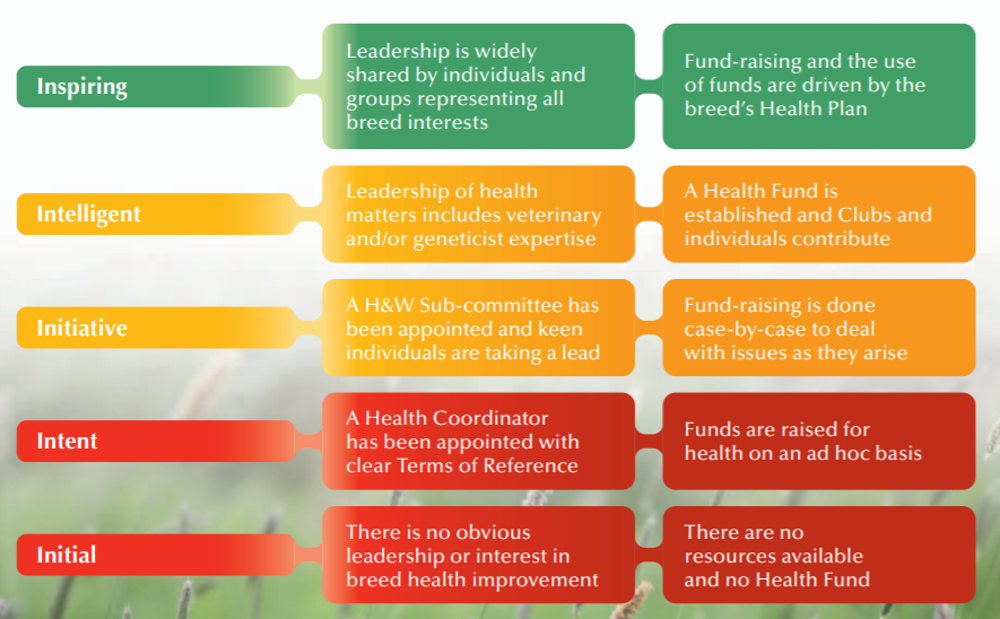
Plan
There are four main aspects of planning that your breed should consider:
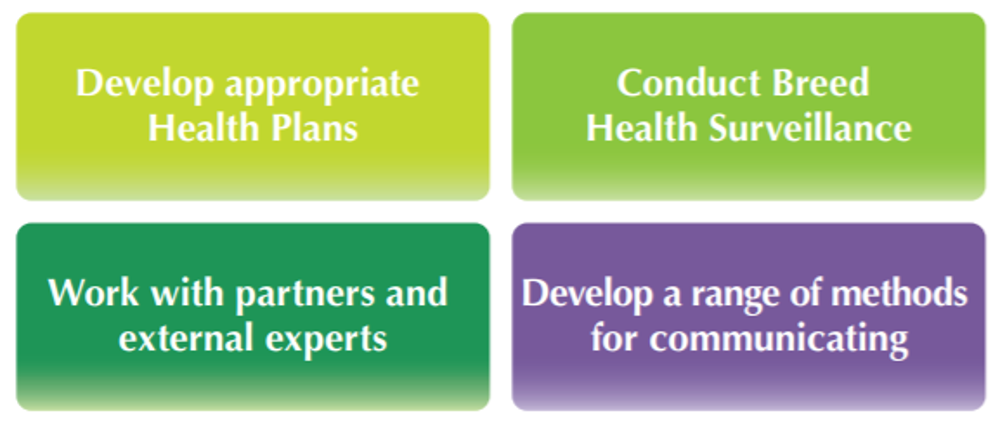
Developing breed-specific health plans means as a breed you should have a way to identify and prioritise the key health issues that you face, such as:
- specific health problems that affect the breed
- health or welfare issues caused by the breed’s conformation
- aspects of genetic diversity that may be causing problems (e.g. popular sires, high inbreeding coefficients, small gene pool)
A health plan should include:
For each of the health issues your breed agrees to address, a specific health plan should include the following:
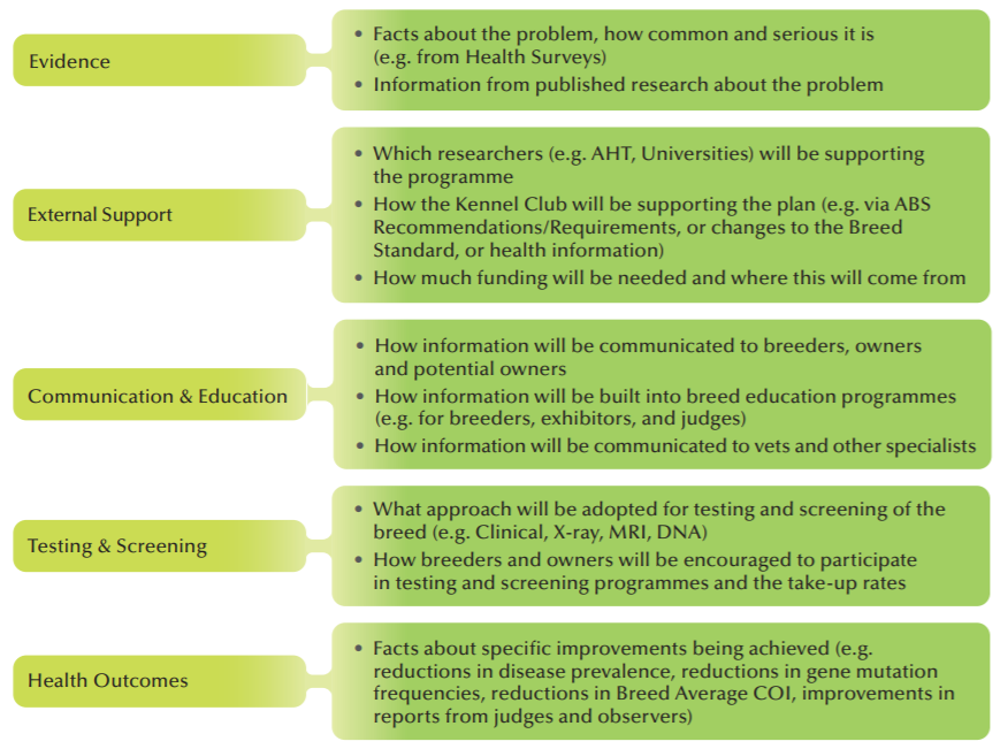
Breed health surveillance is an essential part of health planning
You must develop your breed’s health plans based on health surveys; otherwise you are basing all your plans on anecdotal evidence of problems, or perceptions and prejudices.
Tip: Refer to the health surveys toolkit for more information on how to plan and conduct a survey. If you’ve not done one already, it can be kept quite simple and quick to do and you must publish the results.
Tip: Refer to the health surveys toolkit for more information on how to plan and conduct a survey. If you’ve not done one already, it can be kept quite simple and quick to do and you must publish the results.
Health surveillance is more than surveys
In addition to surveys, you can also find out about health issues in your breed from:
- Discussions in online social networking groups
- Monitoring the take-up and results of health screening programmes published in The Kennel Club’s Breed Records Supplement
- Using the information in the Breed Record Supplement to measure average litter sizes (are they reducing, which might suggest a fertility problem?), or stud dog usage (is there a popular sire who might cause problems?)
- Online databases of breed health issues, such as:
How would you decide on your breed's priorities?
A health survey will tell you about the overall health of your breed and any health concerns it may have. If you are lucky, there won’t be too many issues to tackle, but for most breeds there will be a need to prioritise how and where they put their efforts. Here are some of the factors you will need to consider when prioritising:
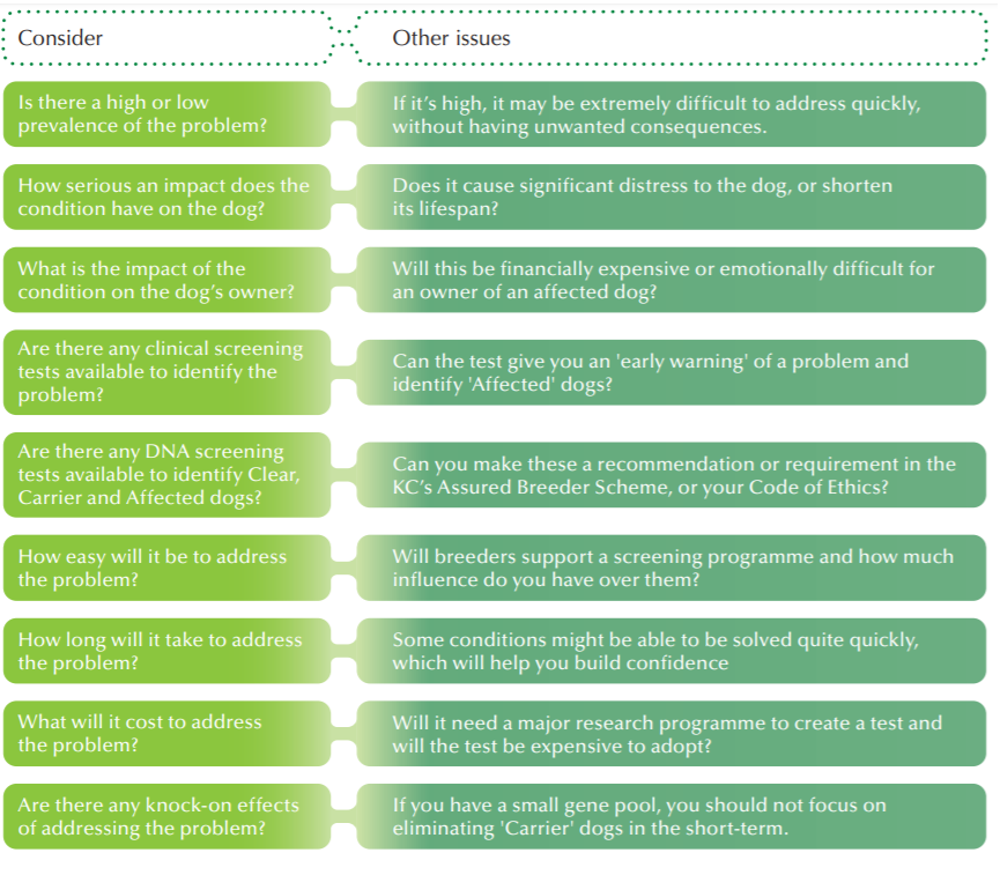
Tip: The general illness severity index for dogs (GISID) is a useful tool to help prioritise diseases based on their severity.
Find out more in the following publications:
Find out more in the following publications:
Publish your breed's health data
Whatever methods you adopt for health surveillance, it is important to publish and communicate this information openly and widely:
- Survey data gathered anonymously will need to be collated and summarised for publication
- Information in the public domain (e.g. from the breed records supplement, or The Kennel Club's website) can be re-published, or you can provide links to the source material
Check: How good are you at planning and surveys?
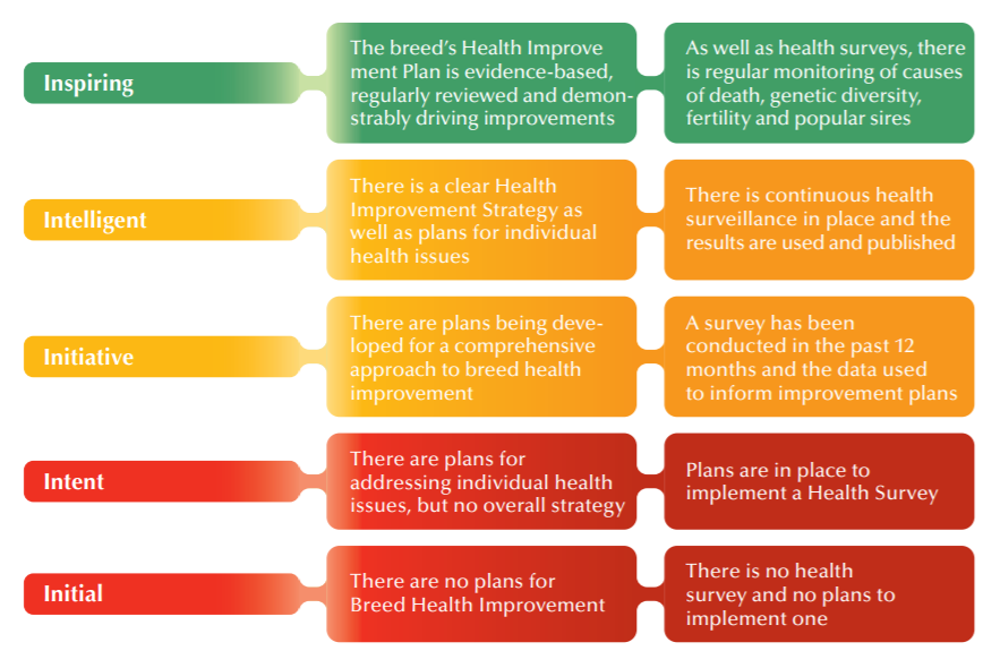
Check: Working with partners and external experts
For most breeds and most health improvement issues, it will be essential to work closely with experts from outside the breed.
These might include:
These might include:
- The Kennel Club’s genetics and health experts, including the Animal Health Trust
- Veterinary experts
- Genetics experts
- Universities, or other specialist research organisations
- Commercial organisations that offer screening tests
Working with The Kennel Club
There are several relatively simple ways in which your breed can work with The Kennel Club to ensure health matters are addressed:
- Agree health and welfare clauses to add to your breed’s code of ethics, which make it more focused on your priorities
- Agree recommendations and requirements to add to your breed’s criteria for The Kennel Club Assured Breeders scheme
- Review your breed standard to ensure its clauses discourage exaggerations, or health issues caused, e.g. by colour or conformation; and emphasise fit for function
Check: How good are you at working with partners and experts?
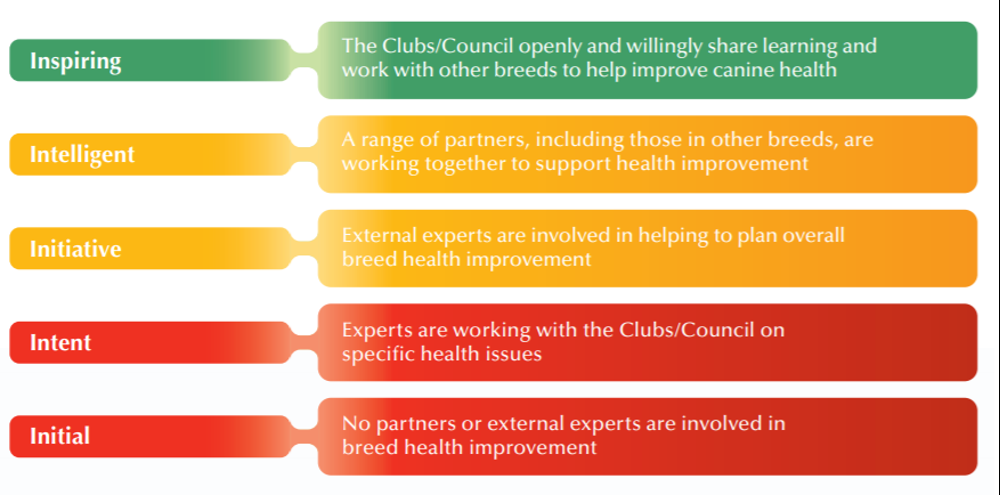
Write a health plan
A good way to summarise the current state of your breed and your plans for the future is to write a breed health plan. This is a document that will help people focus on the facts that you have about health in your breed, using the information described above:
Tip: Your breed health plan should be a “live” document which gives you a useful source of information to feed into your communication plans.
- Health plans for specific diseases and conditions
- Health surveillance data
- Expertise that you are using to help with improvement
Breed health plan
Introduction
- Summarise the purpose of the breed health plan, how it was created and how it should be used
History of the breed
- Describe its origin and function
- Explain how its appearance relates to its function
- Describe its temperament and behavioural characteristics
- Summarise the registration statistics for the past 10 years
Breed health
- Summarise data from health surveys to identify the most significant health problems that affect that breed
- Explain any concerns related to the conformation of the breed and how these affect its health
- Summarise data related to genetic diversity of the breed
- List the specific objectives for addressing any concerns described in the “breed health” section
- Explain the plans that are in place to achieve the objectives
- Summarise the recommendations for anyone breeding puppies. This might include details of screening programmes, advice on coefficients of inbreeding, limits on numbers of litters etc.
Breed-specific judging guidance
- Explain the aspects of the breed that judges are expected to take account of at conformation shows (or other events), together with actions they are expected to take to protect the health of the breed
Possible appendices:
- Breed standard
- Breed Watch (for judges)
- Breed club code of ethics
- Health schemes
- List of Assured Breeder scheme requirements and recommendations (found in our Breeds A to Z)
- Genetics of known health issues
- Working (and other) tests
- The Kennel Club registration trends
- Genetics of coats and colours
Tip: Your breed health plan should be a “live” document which gives you a useful source of information to feed into your communication plans.
Develop a range of communication methods
There is always room to improve communication and it’s one of the aspects of your health improvement strategy that you will have to work at continuously. The key steps in developing effective communications are shown below:

These steps have to be applied to a wide range of communications with various groups:
- Breed club/council officers and committee members
- Breed club members
- Breeders who are not members of your club(s)
- Current owners of your breed
- Potential owners of your breed – puppy buyers
- The Kennel Club
- Judges
- Researchers, vets, geneticists and other specialists
- Campaigners and lobby groups
- The media (including the specialist dog press)
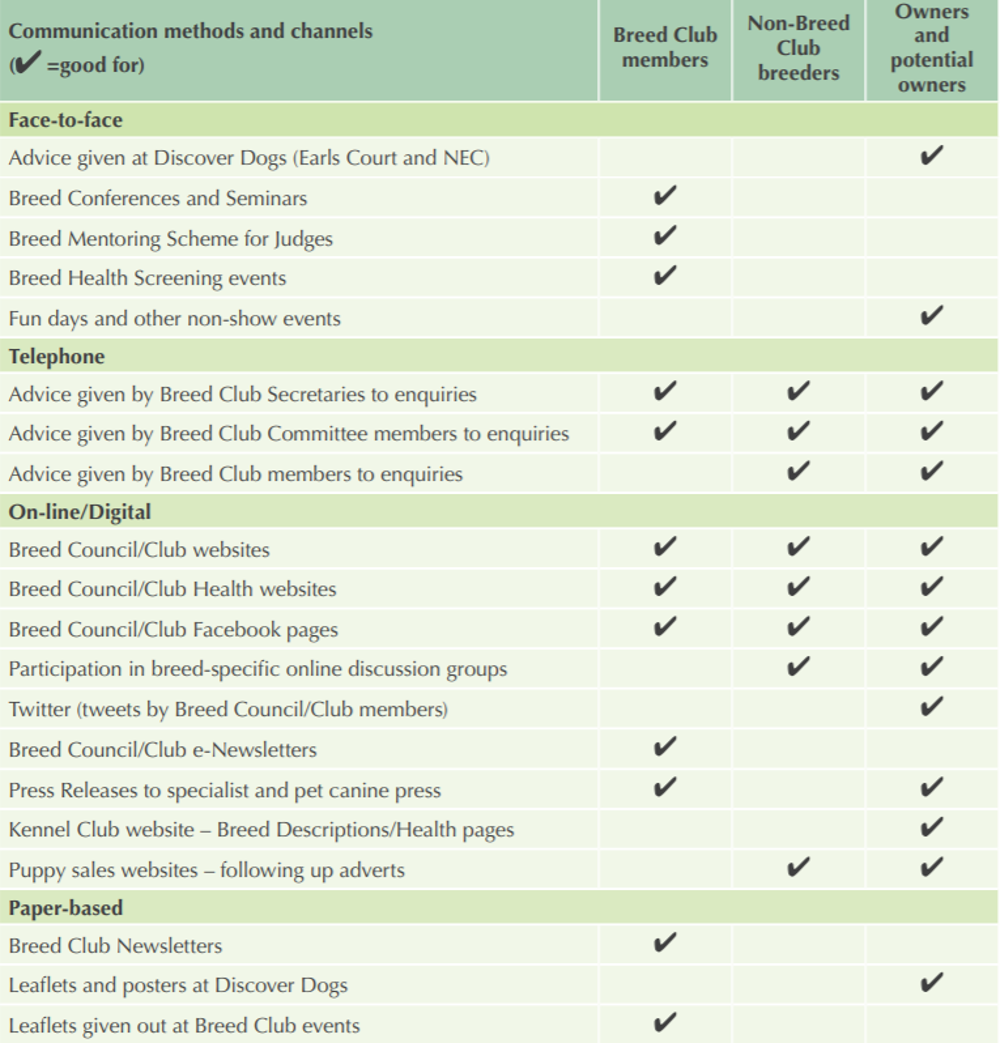
Tip: You need to adopt a broad mix of communication methods and they should include opportunities for two-way communication (consulting) as well as one-way (telling).
Tip: Publish a guide for judges to explain what their responsibilities are when looking at dogs from your breed in the show ring, or in other competitions, or add contributions to The Kennel Club’s Breed Watch and ask judges to review it.
Tip: Publish a guide for judges to explain what their responsibilities are when looking at dogs from your breed in the show ring, or in other competitions, or add contributions to The Kennel Club’s Breed Watch and ask judges to review it.
Check: How good are you at communicating your breed's plans and achievements?
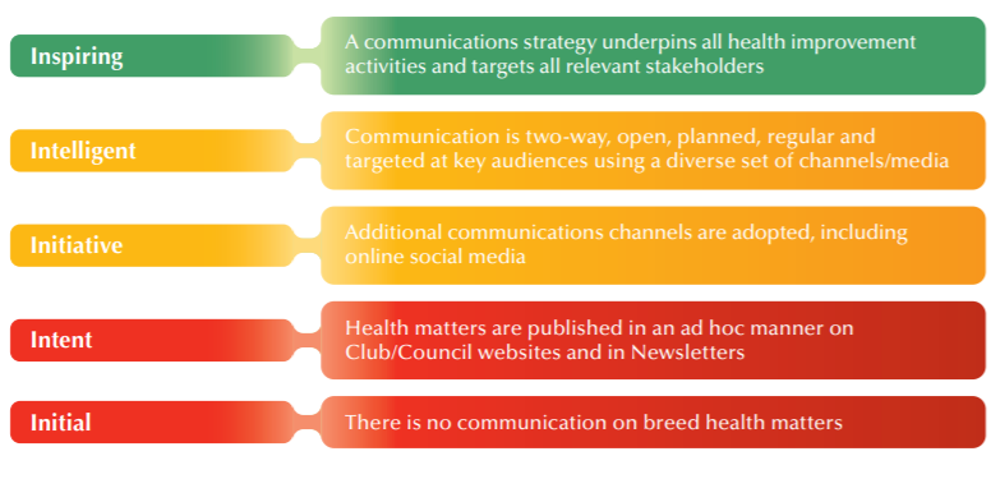
Your breed's website
A website is one of the most important tools to have in your communication strategy for health matters. Anyone interested in your breed’s health will search for a website to find answers to their questions on health.
The Kennel Club will be providing further support to breeds to help them develop their online health information. This is likely to include:
The minimum set of information your breed should be providing online is as follows:
If you are more confident, or experienced, in building a website, you will probably want to consider including much of the following content:
The Kennel Club will be providing further support to breeds to help them develop their online health information. This is likely to include:
- adding breed-specific health information on The Kennel Club website in the Breeds A to Z
- providing guidance, templates and recommendations on online website creation tools that breed clubs can use to create their own bespoke health websites
The minimum set of information your breed should be providing online is as follows:
- What are the top 3 health issues in your breed?
- What is your breed doing about these issues?
- What screening schemes are required or recommended?
- What advice do you give to people wishing to breed?
- Puppy buyers will want to find a healthy puppy from a reputable breeder
- Breeders will need to know how to avoid producing unhealthy puppies
- Vets will want to know about research, diagnosis and treatment options
If you are more confident, or experienced, in building a website, you will probably want to consider including much of the following content:
Engage
Whether or not people support and follow your health improvement plans is a good test of engagement. If people aren’t “with you”, there will be little or no health improvement.
How would you know you are succeeding in this area of your strategy?
You need evidence and data to prove that people are supporting your breed’s approach and you need to collect these over a period of time, not just as a one-off activity. Here are some examples of the range of data that you might collect to show how much engagement you are achieving:
- No. of people responding to your health surveys
- No. of samples provided for a DNA bank
- % of litters registered where parents have been health tested
- No. of people visiting your health website
- No. of people signing up for your newsletter/Facebook page etc.
- No. of dogs participating in breed screening events/testing days
- No. of reports submitted to a death register (e.g. monthly)
- No. of people attending breed health and education events.
Check: How well are you engaging with breed clubs and their members?
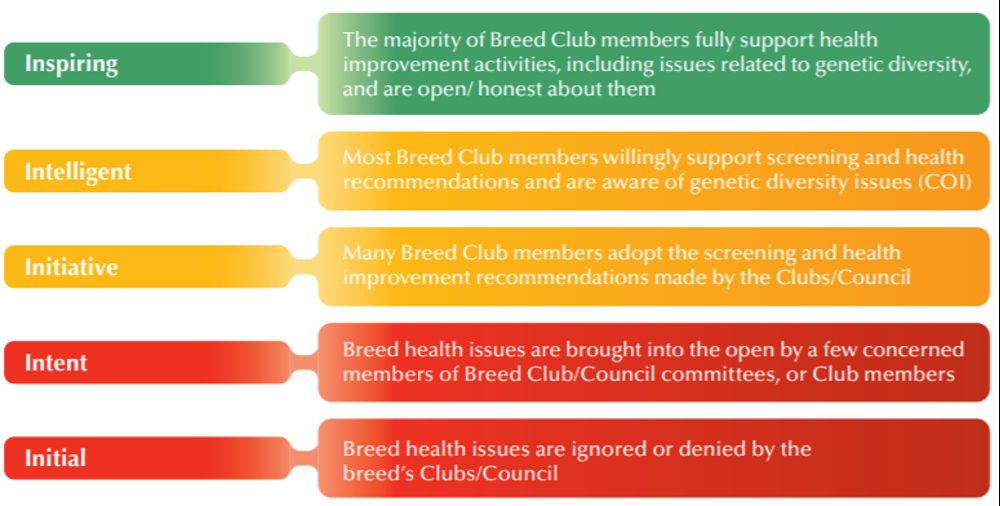
Check: How well are you engaging with breeders who are not breed club members?
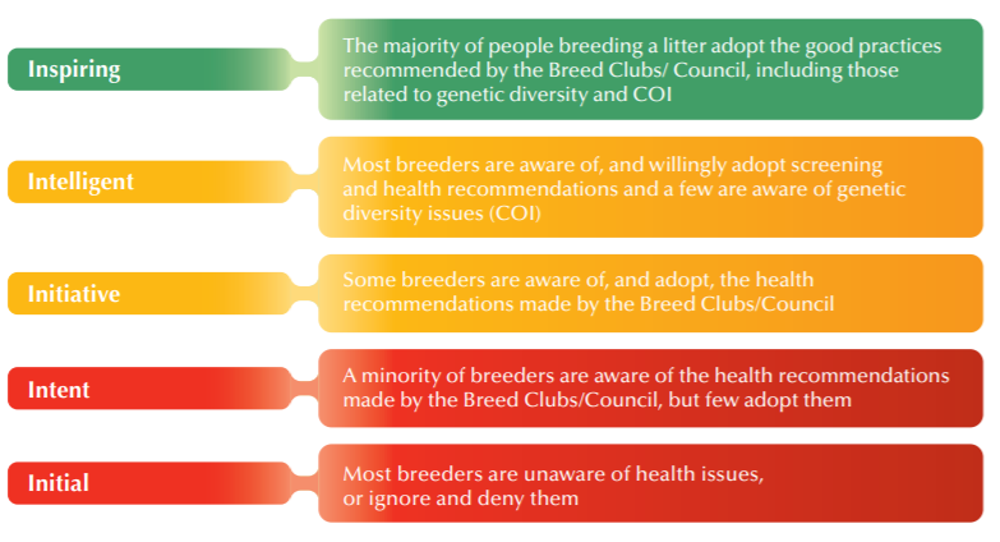
Check: How well are you engaging with owners and potential owners?
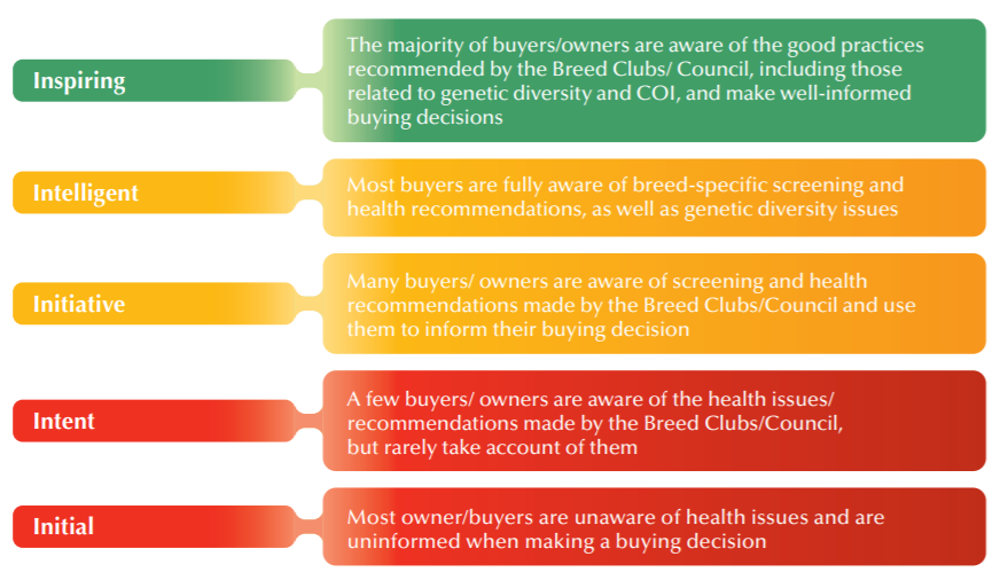
You can’t expect everyone to be supportive right from the start. There is usually a wide range of reactions to any new initiative and some people will be positive much more quickly than others.
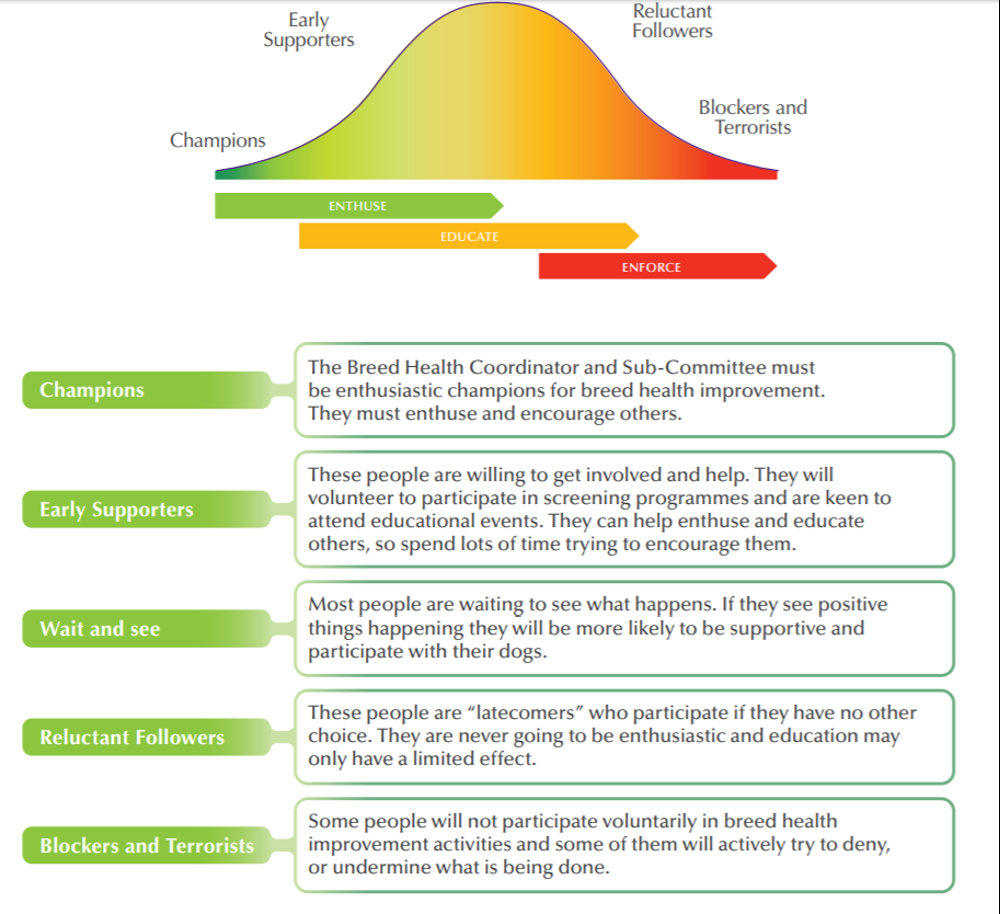
There are some important lessons about how to get started, or how to accelerate what you’re already doing:
- If you wait to develop the “perfect plan”, you will wait a very long time
- If you wait to get “everyone on board”, you will wait a very long time
- Find some “early supporters” who want to work with you to improve things
- Have a go; see what works, then refine it and extend it
Improve
The ultimate test of your breed’s health improvement strategy and the only reason for having one is to achieve better health in your breed. Therefore you have to be able to demonstrate, with evidence, that you have:
- reduced the incidence of the specific health conditions that are addressed by your health plans
- reduced the adverse effects associated with low genetic diversity
- reduced the impact of health or welfare problems caused by your breed’s conformation
Reducing the incidents of health conditions
Where a screening test is available, you should be able to show a trend with a decreasing proportion of affected dogs over time; e.g. as shown below.
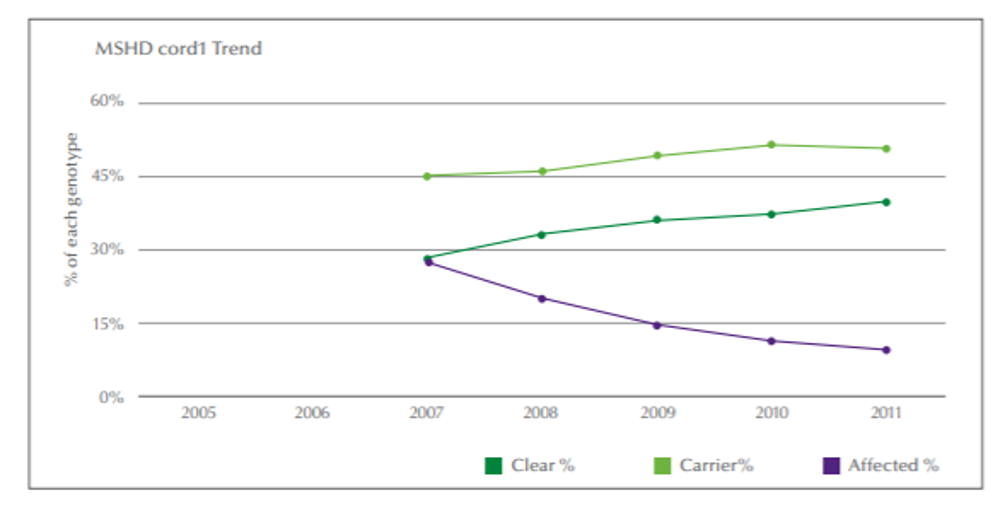
A variation on this is to show the reduction in the frequency of the mutant allele in the population, as shown below:
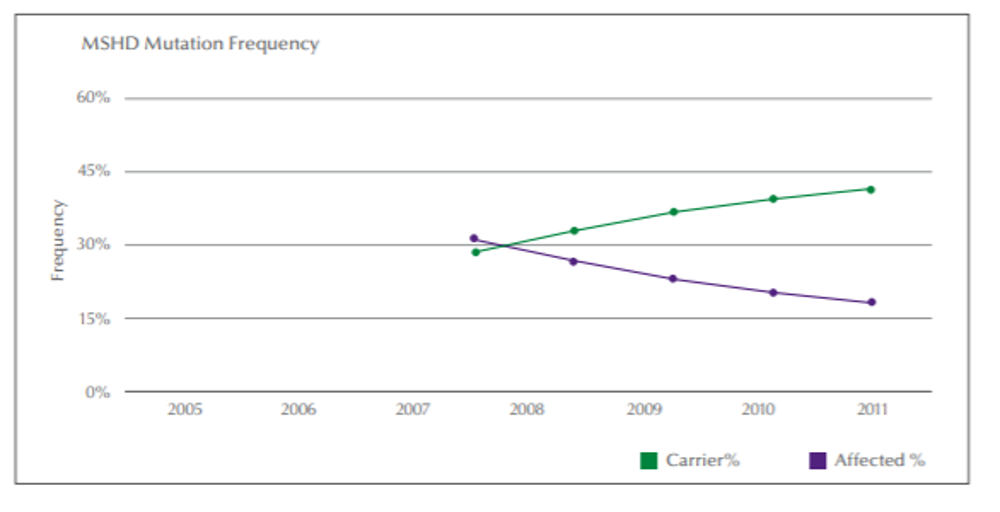
In the case of non-DNA screening tests, such as hip or elbow scoring, a trend graph showing the breed’s mean (average) score will clearly demonstrate any improvements, e.g.:
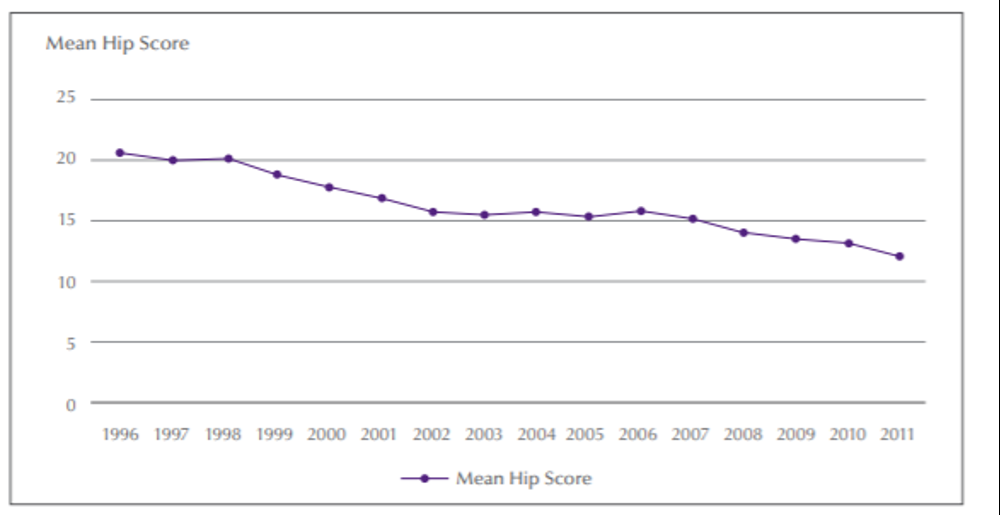
Check how you're doing

Reduce the adverse effects of low genetic diversity
As with demonstrating the impact on disease reduction, it is fairly easy to collect evidence to assess improvements in genetic diversity. This might include:
- Reductions in the breed average coefficient of inbreeding (CoI) reported in The Kennel Club’s Inbreeding Coefficient calculators
- Analysis of average CoI for litters recorded in the Breed Records Supplement
- Data on fertility of dogs and bitches, reported through health surveys
- Analysis of average litter sizes, over a number of years
- Analysis of popular sires, showing numbers of puppies sired and average CoI values of litters
- Increases in numbers of imported dogs with new pedigrees that expand the breed’s effective population size (EPS)
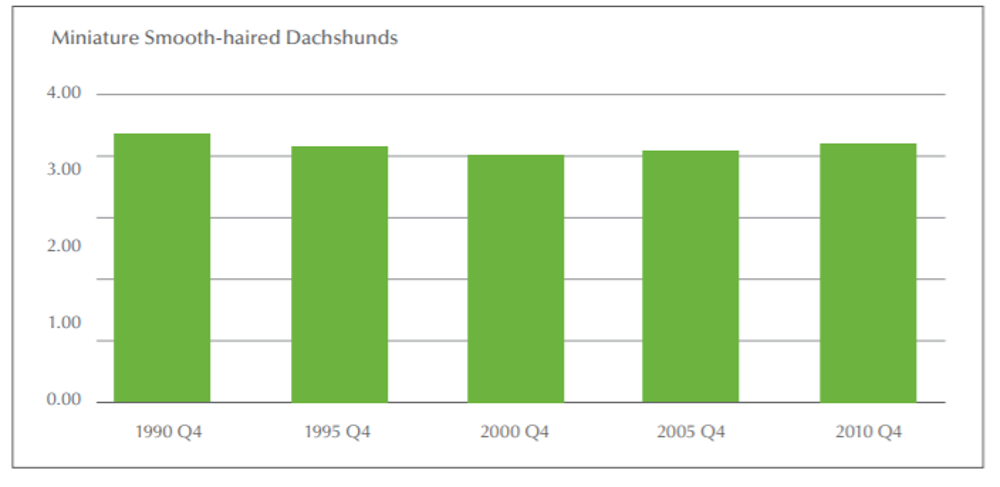
Another simple analysis from the Breed Records Supplement can be used to show the average number of litters sired per stud dog (e.g. per quarter, or per year):

Of course, averages can be misleading and it may be necessary to do further analysis to identify whether a few dogs are disproportionately siring many litters.
Check: How are you doing?
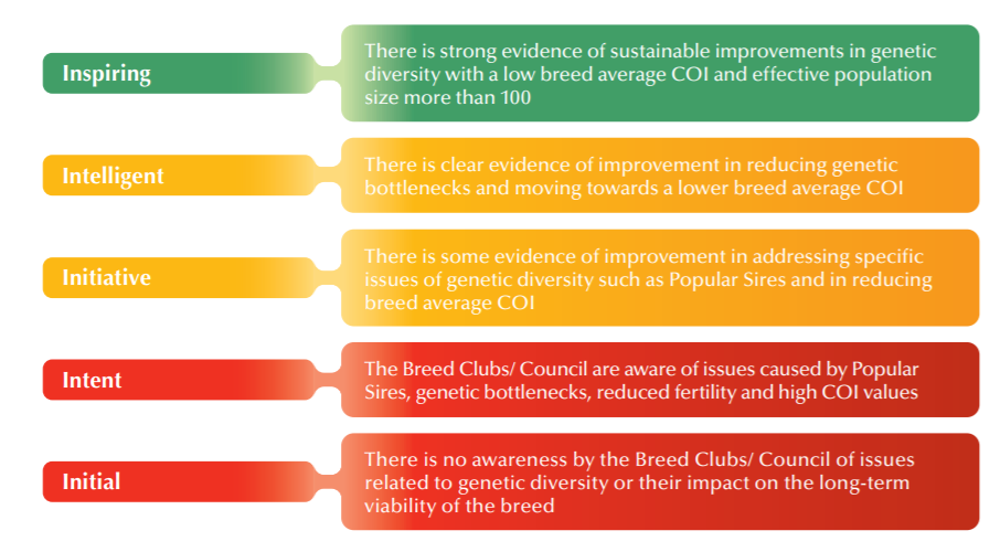
Reducing the adverse effects of breed confirmation
Given the subjective nature of this issue, it may be possible to provide photographic evidence of improvements, e.g. photos of eyes or skin in several successive generations of dogs.
However, for every “good” example, somebody else will probably be able to find “bad” counterexamples. While photographic evidence can be useful, particularly in demonstrating to breeders what is and is not acceptable, the consequences of improved conformation are probably more important. So, you need to be able to extract data from breed health surveillance to show, e.g.:
However, for every “good” example, somebody else will probably be able to find “bad” counterexamples. While photographic evidence can be useful, particularly in demonstrating to breeders what is and is not acceptable, the consequences of improved conformation are probably more important. So, you need to be able to extract data from breed health surveillance to show, e.g.:
- reductions in prevalence of conformation-related eye conditions (e.g. entropion, ectropion)
- reductions in musculoskeletal problems (e.g. slipping patellas, hip dysplasia)
- reductions in numbers of caesarean operations, or whelping difficulties
- reductions in skin diseases
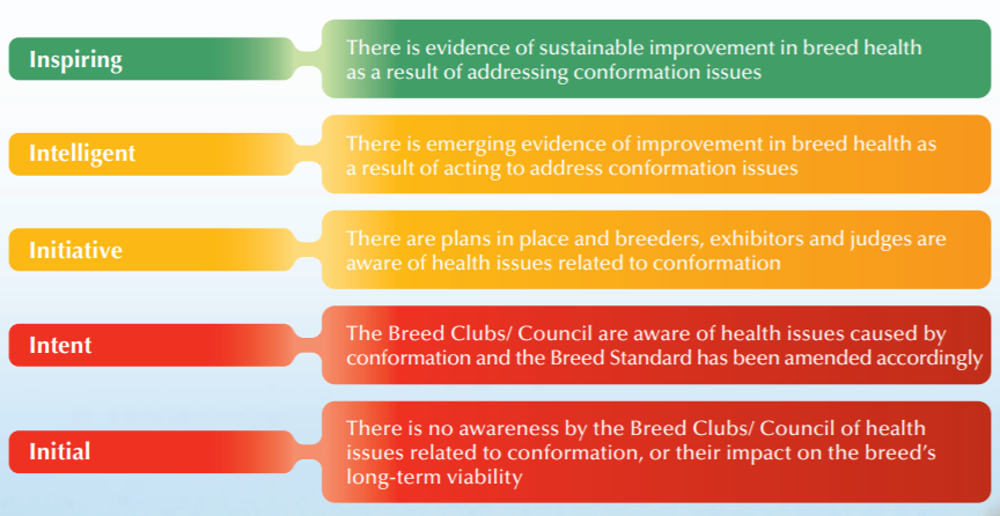
Five steps to develop your breed health improvement stratergy
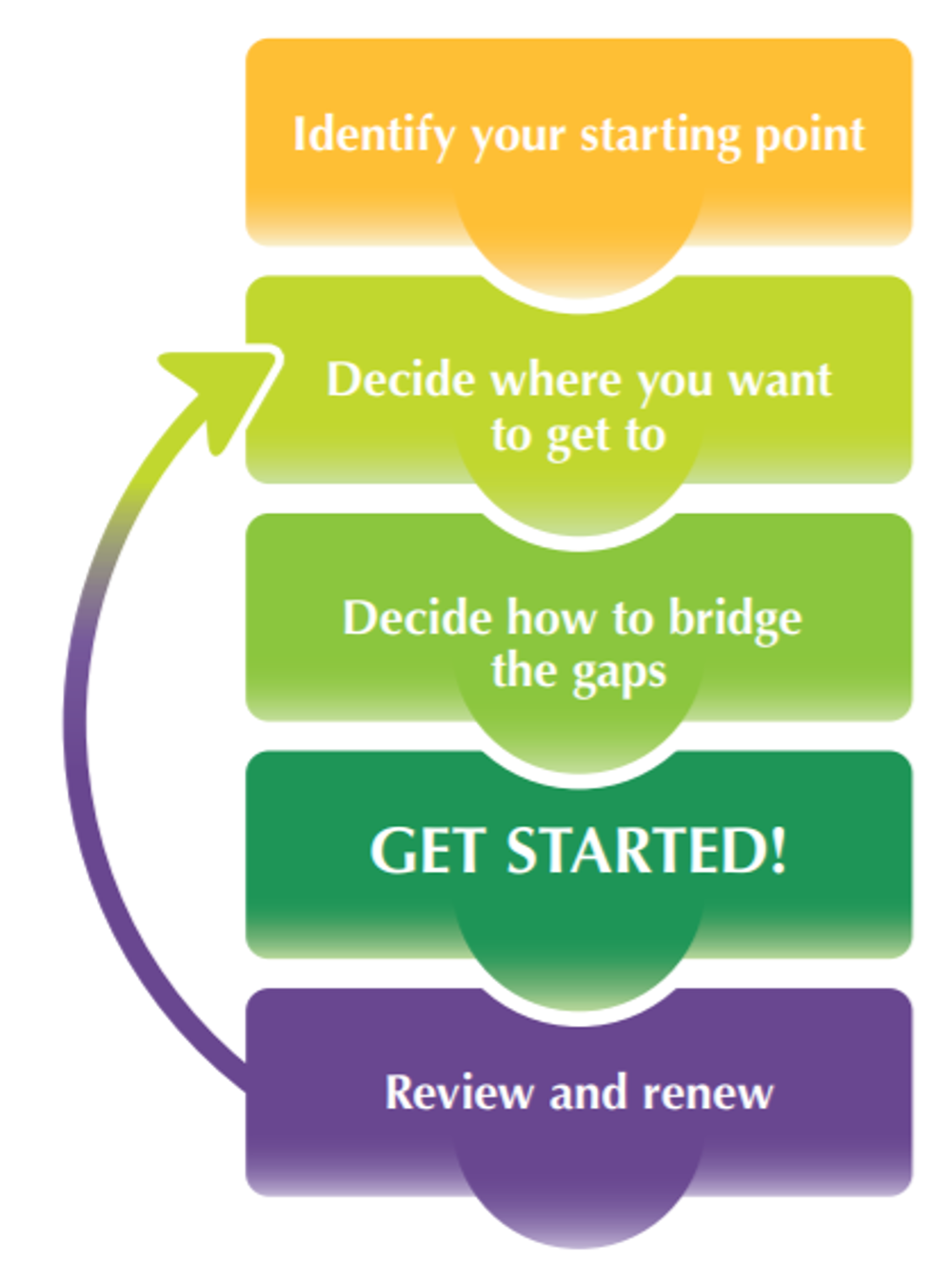
Identify your starting point
Assess your breed using the 5-point rating scales throughout this guide – ideally, this should be done by your breed health co-ordinator and health sub-committee (see example assessment chart overleaf).
- Decide which of the five levels you are currently at, for each of the four areas required in a health improvement strategy:
- Lead
- Plan
- Engage
- Improve
- Identify the key issues your assessment has highlighted and which need to be addressed in your breed
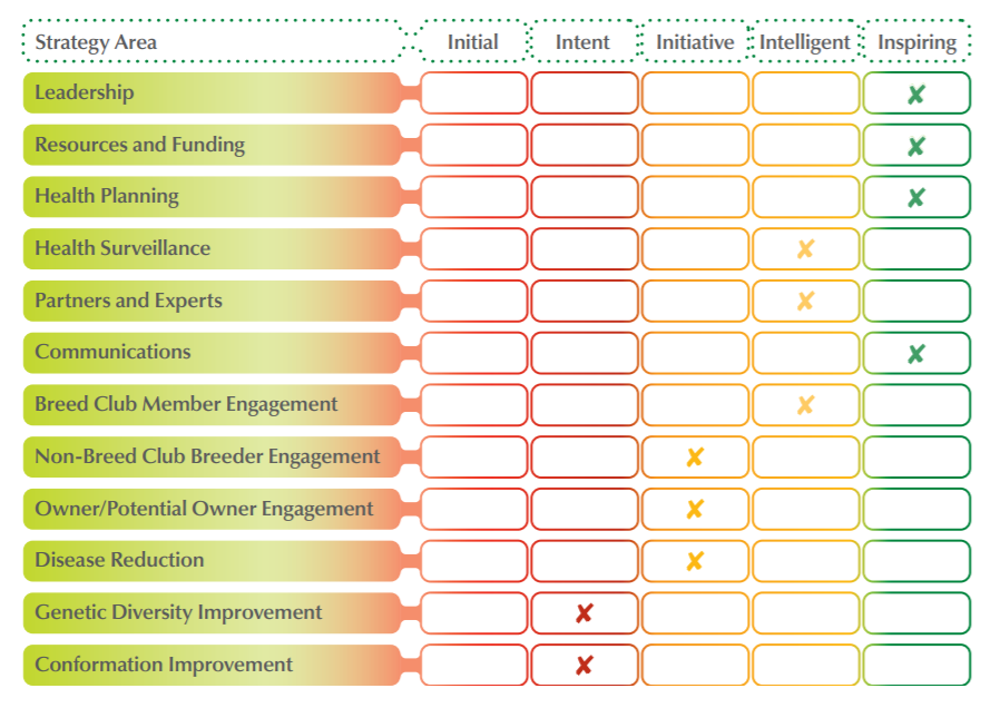
Decide where you want to get to
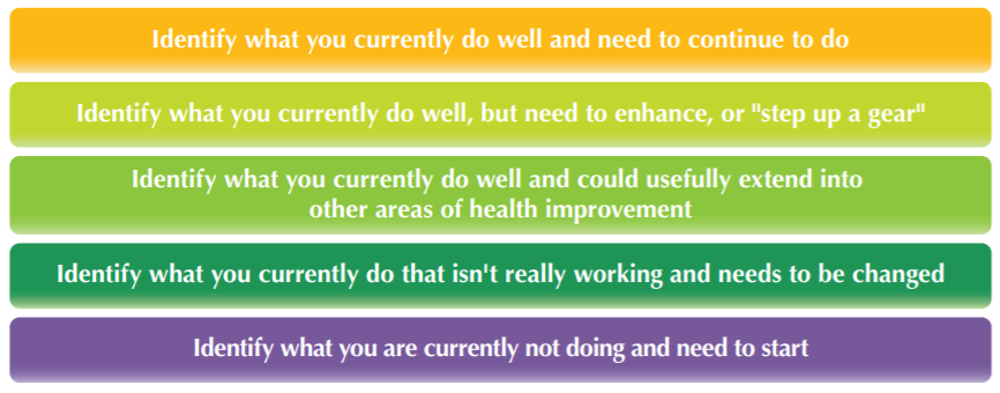
Be realistic about what you want to achieve and how quickly you can achieve it.
- Leadership and planning objectives can be achieved within 1-2 years
- Engagement objectives will take longer to achieve; perhaps 1-4 years
- Health improvement objectives may take 4-10 years to achieve, depending on your breed’s starting point and the range of issues to be addressed
Decide how to bridge the gaps
Identify the most important and practical opportunities for further improvement:
- Where can your breed make better use of its strengths?
- Where can you learn from good practice in other breeds and apply it in your own?
- Where could you be more systematic in the way you do things?
- Where do existing initiatives need better coordination or organisation?
- Which elements of the “enablers” (leadership and planning) will have the biggest impact on the “results” (engagement and improvement) that your breed needs to achieve?

Review and renew
Review progress at least twice a year with your health and welfare sub-committee, to ensure your planned actions are being implemented. Ensure the breed clubs/council are aware of progress, successes and barriers.
Review how relevant and appropriate your current actions are, because:
Tip: Writing and issuing an annual health report for your breed is an ideal way to summarise the work you are doing, what you have achieved and your plans for the future. Don’t forget to highlight and publicise your positive achievements. This is a good way to get more people motivated!
Review how relevant and appropriate your current actions are, because:
- health priorities can change
- new research findings can open up new opportunities
Tip: Writing and issuing an annual health report for your breed is an ideal way to summarise the work you are doing, what you have achieved and your plans for the future. Don’t forget to highlight and publicise your positive achievements. This is a good way to get more people motivated!
Success factors
- Be open and honest when assessing your breed’s current situation
- Be ready to learn from good ideas and practices in other breeds
- Share your breed’s good practices with others
- Don’t dwell on the past; focus on improving things for the future of the breed
- Use the checklists and questions presented here, as a guide, not a “prescription”
- Don’t expect quick fixes; real health improvement is a long-term commitment
Appendicies
Appendix A - Example role description for a breed health co-ordinator
- Provide a central point of contact between the breed and The Kennel Club for all matters concerning health
- Provide advice, help and support, in complete confidence, to owners/breeders on health matters affecting their dogs
- Provide accurate, reliable and consistent information to breeders/owners and the general public, in order to educate and raise awareness about health issues that affect or could affect the breed
- Liaise with the breed clubs/council to inform, update and consult with them over the breed’s health and other relevant general canine health issues, and to act jointly on their behalf to enable a co-ordinated approach to breed health matters
- Research, compile and publish information and updates on all health matters affecting the breed, via breed clubs/council websites, newsletters/leaflets/flyers, year book and any other relevant publications
- Receive, record and monitor input from owners/breeders concerning reported cases of illness/disease and causes of death, in order to keep abreast of current health issues affecting the breed and be alerted as early as possible to any significant new issues that may be emerging
- Compile annual health reports on behalf of the breed clubs/council for submission to The Kennel Club with their annual returns, and provide additional interim health reports to the breed clubs as and when necessary
- Communicate and liaise with professional associations and institutions (including The Kennel Club British Veterinary Association and The Genetics Centre at the University of Cambridge), veterinary practitioners, referral clinicians, researchers, geneticists, charities and other regulatory or advisory organisations concerned with canine health and welfare
- Keep abreast of developments in canine research, legislation, disease knowledge, both within the UK and worldwide
- Attend meetings, health related seminars, conferences etc. as and when necessary
Appendix B - Example health and welfare sub-committee terms of reference where a breed has a breed council
Main purpose of sub-committee:
To develop policy on health and welfare of the breed, including the prevention of ill-health, the promotion of fit and healthy lifestyles and the reduction of health problems; and make recommendations as necessary to the breed clubs/council.
Key areas of responsibility
- To keep track of emerging information in relation to health and welfare issues relating to the breed and circulate this information to the breed clubs/council in a timely manner
- To liaise with breed council officers, sub-committees and club delegates in order to develop health and welfare policy
- To define health and welfare issues which should be addressed by the breed clubs/council
- To recommend to the breed clubs/council those health and welfare issues which should be pursued as a matter of urgency
- To investigate and, if necessary, initiate research into current and potential breed health and welfare issues
- To develop recommendations for all breed owners (breeders, exhibitors and pet owners) to follow to ensure their dogs can lead fit and healthy lifestyles
- Produce press releases, with the press officer, of any breed club/council health and welfare information (as relevant)
- To provide advice to breed clubs/council on health and welfare matters
- To ensure articles and information published on health and welfare matters reflect a fair, honest and positive representation of the work being done by the breed clubs/council
Liaison with:
- All officers, sub-committees and clubs/council representatives
- Subject matter specialists (e.g. AHT, The Kennel Club, vets)
The health and welfare sub-committee will be responsible to:
- The chairman of the breed council
Meetings to attend:
- Breed club/council meetings
- Annual general meetings
- Health and welfare sub-committee meetings, as required
- Health and welfare seminars and symposia, as appropriate
Membership and term of role:
- The health and welfare sub-committee will be appointed for three years at a time, with its membership reviewed and confirmed at an annual general meeting of the breed council
- The chair of the health and welfare sub-committee will be appointed by the breed council
- The health and welfare sub-committee may second additional members, as required, to deal with specific health and welfare issues
Other information:
- All sub-committee correspondence should be copied to the breed council secretary
Appendix C - Example annual health report contents
1. Chairman’s introduction
- Leadership
- Health and welfare sub-committee
- Pet advisors
- Health fund
2. Planning
- Breed health improvement strategy
- Health surveillance
- Partners in health improvement
- Communications
3. Breed health improvement
- AAA disease (plans and progress)
- BBB disease (plans and progress)
- CCC degeneration (plans and progress)
- DDD blindness (plans and progress)
- EEE syndrome (plans and progress)
- Watch list of other health conditions
- Breed health improvement – conformation (plans and progress)
- Breed health improvement – genetics and diversity (plans and progress)
4. Priorities and plans for the next 12 months
Appendix D - Example health plan template for an individual disease
Condition
- Give the veterinary name of the disease/condition
Also known as...
- If the disease has alternative, or colloquial, names, list them
Description
- Describe the symptoms of the disease/condition and how it is usually diagnosed
Prevalence
- Describe how widely this disease/condition affects the breed and whether its prevalence is increasing/decreasing or not changing (e.g. as a result of actions already taken)
Severity (GISID 0-16)
- Describe the severity and impact of the disease/condition. Consider using Asher’s GISID rating scale (see main text in this guide). Describe the normal treatment options for the disease/condition and their success rates
Age of onset
- State at what age the disease/condition appears
Health screening
- Explain any health screening currently in place and advice to breeders (voluntary/recommendation/requirement), or explain any plans in place to develop health screening, if none currently exists, including timescales/funding/experts involved
Advice to buyers
- Explain the advice you would expect to give in relation to this disease/condition, to a potential buyer of the breed
More information
- Provide references to further information about the disease/condition, or to your breed’s plans to address it (e.g. website addresses, scientific papers). Give contact details for your breed’s point of contact on this disease/condition.
Note 1: Health screening
Voluntary: where a test is available for a condition that is not considered by the breed clubs/council and their health advisors to be of significant prevalence or severity to justify being a recommendation or requirement.Recommended: where a test is available, but has not been recognised as an official screening or control scheme by The Kennel Club. Breeders are expected to use the results of the test to inform their breeding decisions and should not, knowingly, carry out matings that are likely to produce "affected” puppies.
Required: where a test is available and has been approved as an official Kennel Club screening or control scheme. Breeders are expected to use the results of the test to inform their breeding decisions and should not, knowingly, carry out matings that are likely to produce “affected” puppies.
Acknowledgements
We wish to thank the following people for their help in developing this toolkit:
Main author
Ian Seath
The project team
Judith Ashworth, Sheila Atter, Archie Bryden, Brian Hill, Dorothy McIntyre,
Shula Shipton and Marion Wilks
